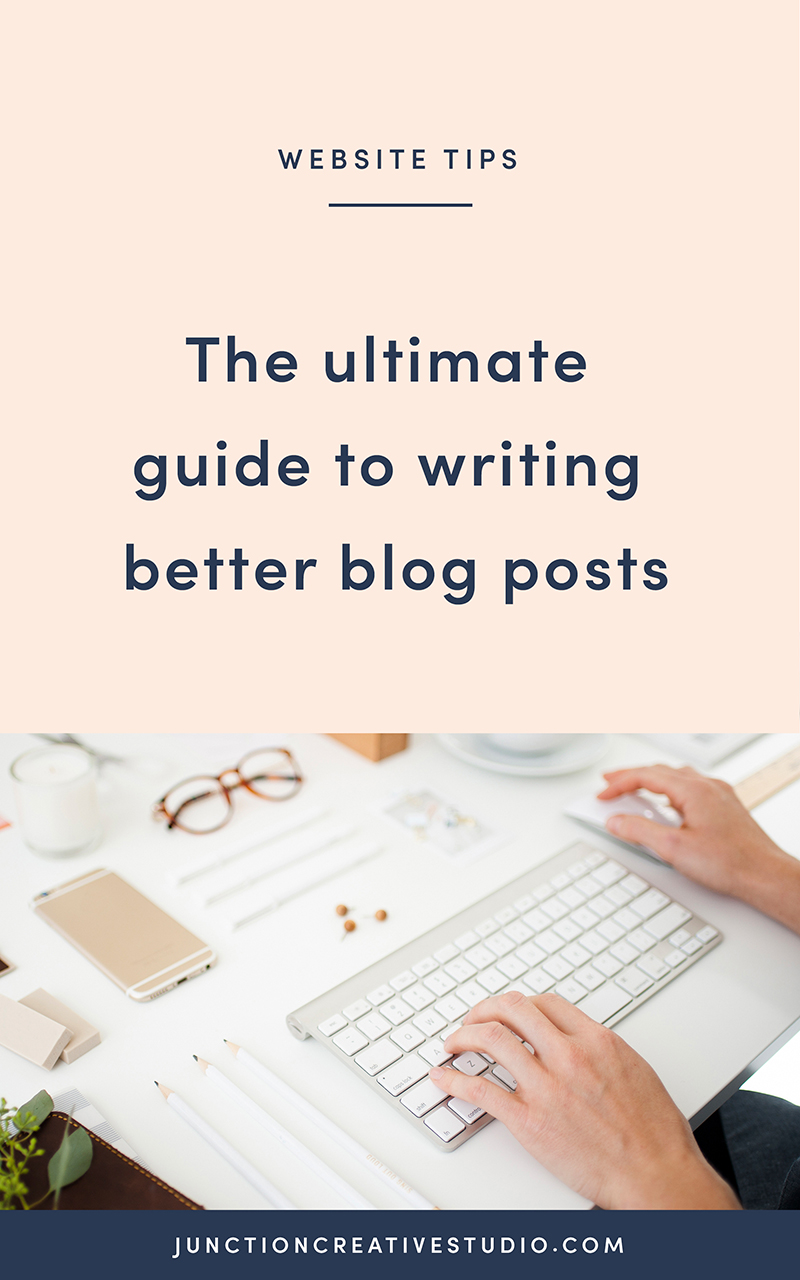Let me guess: You’ve come to terms with the fact that you do, in fact, need to start a blog for your business and you’re ready to embark on your content creation journey.
Or perhaps you’ve been producing content without achieving the success you’d hoped for so you’re ready to learn the “secrets”.
Okay, here it is: the biggest secret I can share about how to create high-quality content…is that there is none.

How to Write Better Blog Posts
I know you wish there was some fascinating and unique approach you would never have considered and that this is what’s been holding you back. But the truth is, the key to creating high-quality content is rooted in 12 basic concepts that I’m sure you’ve heard before.
The way to achieve blogging success is routinely considering each of these concepts as you develop your content.
Don’t believe me? Okay, let’s take a look at these 12 key content concepts. You’ll be shocked at how basic they seem and shocked again by how successful your content efforts will be once you employ these guidelines consistently. Let’s get going!
Keep Your Ambition in Check
As any good entrepreneur might, you likely have some business-aligned motivation for generating content. For instance, driving traffic to your site and/or engaging prospective clients in a conversation with the hopes of conversion.
While this can certainly continue to be the underlying purpose of serving content to your audience, the objective to keep in mind when actually writing content is how you intend to help your audience achieve whichever goals they might be after. This is everything.
Don’t get caught up in “slyly” incorporating all of the ways to sell yourself and your business. In this case, less is more and there is a time and place for everything. And I think those cliché phrases will suffice.
Have you heard of the 80/20 rule? Elle & Co. summed it up well in advising that: “80% of the time your blog posts should be helpful and chalk full of tips and strategies to help your readers with their biggest struggles. And the other 20% of the time you can organically mention your product or service when it’s appropriate. It’s a delicate balance, but one that works!”
Provide Value to Your Audience
The relationship you build with your audience should be built on a foundation of trust. Your audience expects you to share relevant information that will provide value to their lives and/or work. When you don’t deliver on this front, you will immediately lose your audience. With one click they’ll exit the browser without a glance back.
It’s critical for you to put yourselves in the shoes of your intended audience and truly consider what is important to them. This should guide the creation of your content before all else. Start by pinpointing their struggles, challenges, questions, and concerns. Your content should be designed to address these elements with helpful advice or commiseration where appropriate.

Commit to Consistency
We are all creatures of habit; some more so than others, and this is never more clearly demonstrated than with readers seeking out content. Whether conscious or not, they grow to expect consistent messaging from you at regular intervals. Whether they’re receiving your content by email via a newsletter or regularly returning to your site for new nuggets of wisdom, it’s important that you provide content in a consistent manner.
Be honest with yourself about the quantity you’re capable of producing. Weekly blog posts are only better than monthly posts when you are able to consistently deliver. If you know you will be stretching yourself to produce thoughtful content on a weekly basis, you’re far better off lengthening your intervals.
When you can commit to consistency you are communicating a level or reliability and dependability your audience can learn to expect from you. It will also elevate the general sense of respect attributed to your business when it comes to legitimacy. Don’t let your readers down because they’re also a fickle bunch. The moment you let them down, you stand to lose them…and the trust you’ve been diligently building can crumble overnight.
Get Creative with Your Title
It’s a good rule of thumb to create your title before you start writing as a way of grounding and organizing your thoughts as you compose. But don’t let that stop you from changing your mind. Once you write your piece scan through in case there are some initial lines that jump out at you.
Oftentimes, writers get so caught up in the idea of writing a title that it stalls their creativity, and they discover they’ve written a much more descriptive title for their post within the content itself. On the other hand, there are times when you begin a piece with one set of intentions and upon completing the piece you realize you’ve reached different conclusions.
Either way, review your title once more once you’re done writing to determine if the title still accurately mirrors the message you’re trying to convey, and then adjust accordingly. Don’t forget to take into account the relevant SEO-friendly keywords that should be included in your title based on your content.
Keep Your Content Organized
Start by outlining the general points you plan to make into digestible chunks. Beginning with a clear outline will help you figure out your overall messaging objective and plan. You’ll find it’s much easier to stay true to your content goals if you can reference an outline breaking out the main ideas of each section.
Once your outline is clear, be sure to label your sections of information with sub-headers. If your reader is scanning the page—and let’s be real, they are—you want to make it as easy as possible for them to hone in on the sections that resonate with them most. Establishing appropriate sub-headers (or h-tags) can also contribute to improved SEO for your blog posts. It’s really a no-brainer.
Get to the Point…Fast!
Depending on your writing style you might be compelled to use flowery language and metaphors to endlessly describe your point. When it comes to high-quality content for driving readership and engagement—don’t do this! Your reader wants you to get to the point quickly.
As their eyes scan down the page, assuming you’ve built up the sub-headers for your sections of copy, they’ll stumble upon a phrase that speaks to them and they’ll venture on to the paragraph beneath. If you don’t spit it out your reader may get frustrated and give up. The objective is to make reading your copy is little work as possible.
Help your readers out by being direct and giving them exactly what want as quickly as you can.

Be Explicit in Your Clarity
Tell your audience what you’re going to tell them, tell them what you want to tell them, and then tell them what you told them. This technique is tried and true and helps you be even clearer about your intentions for the piece. Your outline should establish a clear enough framework to make the actual topic accessible. Finally, your summary should remind your reader what it is you intended for them to learn.
If by chance there is any confusion about the point of the piece, this method will help clear that up. What’s more, it should help you stay true to the task you started out to complete.
Create Relevant Hyperlinks
Conduct your due diligence and research your topic to confirm your findings or discover further support for your assertions. Who knows, you may even find you’re wrong about something.
Keep track of your sources and be sure to link out to them as references. This adds further legitimacy to your claims and also helps when it comes to SEO.
In this same vein, be sure to capitalize on the opportunity to link out to any previous posts you may have written that coincide with the topic you’re covering in this post. This gives your reader a chance to further engage with your content—always a good thing.
When linking to other posts, be sure to use relevant anchor text. Meaning, instead of having the user click on an ugly URL or a phrase like “click here”, hyperlink keywords that correlate with the page being linked to.
Go to Great Lengths
The appropriate length of a blog post is something that has been subject to much debate over the years. The truth is you’re better off writing lengthy posts around 1200 words. I know! I know! But trust me, this is good for several reasons.
Writing lengthy posts forces you to be thorough and this level of detail only increases the chances that your reader will find something worthwhile within your content. If you incorporate sub-headers and break your content into digestible chunks, you will circumvent short attention spans and allow the eyes to flit to what most interests your reader.
What’s more, we’re all beholden to Google and it likes lengthy posts. So do the right thing and get wordy!
Consider Dynamic Content to Accompany Your Copy
Given the various types of learners and corresponding attention spans you are wrangling with when serving up content to the masses, it’s important to consider adding additional dimensions to your content to further engage your reader based on who they are, where they are, and when they’re reading.
Some readers prefer a bit of audio after a tired day of reading computer screens at work, while others still enjoy a good video. If there’s an opportunity to embed these elements into your content, take advantage of it. Consider recording either the entire blog post or certain snippets by audio or video.
If you can create a separate piece of collateral as a freebie, feel free to repackage aspects of your content for this purpose. Providing your reader with something to take with them is always a win.
Encourage Your Readers to Act
At the end of the day, you want to ensure your readers have a clear path to action. Make sure you establish a relevant call to action at the end of the piece instructing your reader to read an additional post, download a freebie, sign up for a newsletter, etc.
Re-share Your Content
You’ll likely make sure to share your content via social media channels and email newsletters as soon as you initially publish content. But don’t forget that it’s always possible for interested readers or new readers, for that matter, to miss out on previously published content. Be sure to take a look at some of your more evergreen pieces and re-share those within your networks to maximize the exposure of your content.






